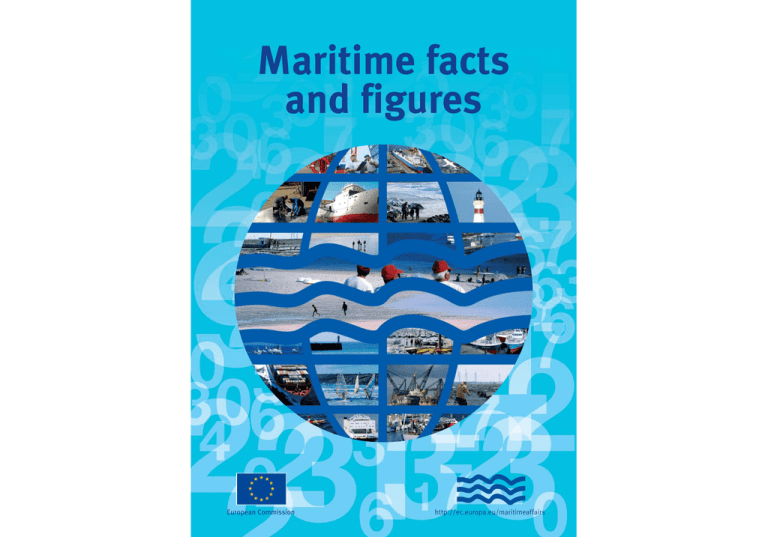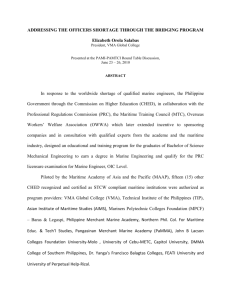Maritime facts and figures European Commission
advertisement

Maritime facts and figures European Commission http://ec.europa.eu/maritimeaffairs WHY LOOK AT THE OCEANS IN AN INTEGRATED MANNER? GEOGRAPHY AND POPULATION So far, EU policies on maritime transport, industry, coastal regions, offshore energy, fisheries, the marine environment and other relevant areas have been developed separately. Of course, there has been an effort to ensure their impact on each other was taken into account. But no one was looking at the broader links between them. No one was examining in a systematic manner how these policies could be combined to reinforce each other. And yet, activities on oceans and seas are increasing so much that the conflicting uses of the oceans are becoming more difficult to manage as can be seen below: From the earliest times, the oceans and seas have played a leading role in the development of European culture, economy, identity and history. North Sea: Existing and Prospective Uses and Nature Conservation Boundaries Continental Shelf/EEZ Territorial Waters/12 nm Zone Shipping D D ee nn m m aa rr kk Traffic Separation Scheme Restricted Area Anchoring Area Did you know? • The continent of Europe is surrounded by four seas: the Mediterranean, the Baltic, the North Sea and the Black Sea; and by two oceans: the Atlantic and the Arctic. • Europe’s Outermost Regions result in areas of Europe also being surrounded by the Caribbean Sea and the Indian Ocean. • The maritime surface areas under the jurisdiction of the Member States are larger than the total land area of the European Union. • The European Union has a coastline of 68 000 km – that is over 3 times longer than that of the US and almost 2 times that of Russia. • No European resident lives more than 700 km away from the coast. • Almost half of the Union's population lives less than 50 km from the sea, although the population is concentrated in urban areas along the coast. Platforms Coastal zones Population density (Inhabitants per km2) Petroleum Platform (In Use) Natural Gas Platform (In Use) Pipelines Natural Gas (In Use) Offshore Windfarms (Pilot Phase) In Use Approved Share of population Sediment Extraction 20 Mill. Inhabitants In Use Dumping Grounds External Data Sources: See Special Theme Maps Büsum Coastal population Inland population Dredged Material (In Use) Ammunition (Out Of Use) Dredged Material (Out Of Use) Coastal zone: Stripe of 50 km along the coastline Nature Conservation Natura2000 SPA Natura2000 SAC Cuxhaven The legend is not exhaustive Norden Wilhelmshaven Bremerhaven Emden N N ee tt h e r l a n d s Oldenburg BREMEN With permission from the Bundesamt für Seeschifffahrt und Hydrographie. It is now time to bring all these elements together and forge a new vision for the management of our relations with the oceans. The Green Paper examines how this can be done in order to provide the best possible framework to forge this vision. 2 Statistical data: Eurostat — Database: REGIO © EuroGeographics, for the administrative boundaries Cartography: Eurostat — GISCO 3 COASTAL REGIONS THE MARITIME ECONOMY As coastal regions become more attractive, increased attention will need to be paid to the attendant risks such as pollution, floods and coastal erosion and how they may be avoided. A preventative approach and innovative planning are required. Given its export-based economy, the increase in global and regional trade volumes and its geographical circumstances, the EU has a vital interest in the competitiveness of shipping, shipbuilding, marine equipment and port industries. Did you know? Did you know? • Maritime Regions account for over 40 % of Europe’s Gross Domestic Product (GDP). • Between 3 and 5 % of Europe’s Gross Domestic Product (GDP) is estimated to be generated from sea-related industries and services, without including the value of raw materials, such as oil, fish or gas. • Europe has an estimated 8-10 million anglers fishing for sport or pleasure at sea with a related industry of 8-10 billion Euros. • Almost 90 % of the EU’s external trade and over 40 % of its internal trade are transported by sea. • 3.5 billion tonnes of cargo per year and 350 million passengers pass through the 1 200 European seaports. • Europe’s leadership in shipping is beyond any doubt with 40 % of the world fleet. • Aquaculture accounts for 19 % of the Union’s total fisheries production. By 2030, aquaculture will provide more than half of the fish consumed worldwide. Coastal zones GDP in euro per inhabitant 2002 - NUTS 3 • The sea is Europe’s most popular holiday destination: among European holiday makers, 63 % choose the sea as their holiday destination. Size and share of GDP 270,000 Mio Euro • Europe has clean beaches: of the 14 000 coastal bathing areas monitored by the EU, 96.7 % comply with the mandatory values set out in the European Directive on bathing water. Share of GDP in coastal zones Share of GDP in inland zones • There are an estimated 3 000 coastal marinas in the EU with an associated 1 000 000 berths. © Corbis • EU public expenditure dedicated to coastline protection against the risk of erosion and flooding will average €5.4 billion a year for the period 1990-2020. 4 Statistical data: Eurostat — Database: REGIO © EuroGeographics, for the administrative boundaries Cartography: Eurostat — GISCO 5 GOVERNANCE One estimate of turnover of maritime sectors excluding tourism is the following: 2004 The current fragmentation into sectoral policies makes it difficult to reconcile competing uses of the oceans and seas and to define priorities. This can result in the adoption of conflicting measures, which in turn have negative consequences on the marine environment, may impose disproportionate constraints on competing maritime activities, or may limit the benefits which could be drawn from new activities. World value in € Mio European value in € Mio European value in percentage of the world value Shipping & Transport 342 743 151 137 44.1% Marine Tourism Activities 168 189 71 812 42.7% Offshore Oil & Gas 91 146 19 112 20.9% Fish/Seafood Processing 79 859 8 241 10.3% • Within the United Nations system, there are 12 Organisations involved in maritime policy making. Marine Equipment 72 871 16 675 22.9% • The European Community and its Member States are parties to more than 100 multilateral agreements relating to Maritime Affairs. Fishing 55 983 4 758 8.5% • 7 Commissioners from the European Commission responsible for different policy areas direct a common Task Force to look at the oceans and seas in an integrated fashion. Shipbuilding 37 746 13 143 34.8% Ports 25 017 10 478 41.9% Marine Aquaculture 23 876 3 483 14.6% Cruise Industry 12 000 2 365 19.7% Research & Development 10 629 3 273 30.8% Seaweed 5 988 n/a* n/a Marine Commerce 6 840 2 736 40.0% Marine IT 3 570 1 382 38.7% Minerals & Aggregates 2 741 1 344 49.0% Renewable Energy 128 121 94.5% Marine Biotechnology 2 190 n/a n/a Submarine Telecoms 1 126 185 16.4% Ocean Survey 2 013 538 26.7% Education & Training 1 537 n/a n/a Did you know? From left: Commissioner for the Environment Stavros Dimas, Commissioner for Science and Research Janez Potočnik, Commissioner for Transport Jacques Barrot, Commissioner for Regional Policy Danuta Hübner, Commissioner for Fisheries and Maritime Affairs Joe Borg, Commissioner for Enterprise and Industry Günter Verheugen, Commissioner for Energy Andris Piebalgs. • At the European level, there are 6 agencies dealing with matters related to the seas; FRONTEX (the European agency for the management of operational cooperation at the external borders of the Member States), European Defence Agency, European Space Agency, European Maritime Safety Agency, Community Fisheries Control Agency, and the European Environment Agency. • There are many examples of bilateral cooperation between individual Member States. 6 *n/a: non applicable. Source: Marine Industries Global Market Analysis. Irish Marine Institute, 2005. • The responsibilities for different maritime activities on coastal waters are attributed and coordinated differently within Member State governments. 7 THE MARINE ENVIRONMENT The preservation of the marine environment is key to improving the EU’s competitiveness, long-term growth and employment and it is important for life on earth. • In 2003 there were 4 116 registered Marine Protected Areas (MPAs) covering over 1.6 million square kms all over the world. This represents less than 0.5 % of the seas and oceans. Did you know? • A deterioration of the marine environment is leading to widespread algal blooms in the Baltic. • Over 70 % of the Earth's surface is covered in water, with an estimated volume of around 1 360 000 000 cubic kilometres. Over 97 % of all water is found in oceans. • As a result of global climate change, mean sea level will rise between 9 cm and 88 cm by 2100 as compared to 2000. • Half of Europe’s wetlands are expected to disappear by 2020. “The Zwin, Knokke-Heist, Belgium (photo by Kris Struyf).” • The beaches of the Amana reserve in the French Guiana are home to half the world’s leatherback turtles. • On the basis of the latest scientific assessments made by the International Council for the Exploration of the Sea (ICES), Community fish stocks are being fished at between two to five times more than the level that would provide the maximum sustainable yield from those stocks. Satellite Picture of Algal Bloom in the Baltic — June 2005. State of exploitation of marine fishery resources Northwest Atlantic Northeast Atlantic Western Central Atlantic Eastern Central Atlantic Mediterranean and Black Sea South West Atlantic Southeast Atlantic 0% 10% Underexploited Overexploited 20% 30% 40% 50% 60% Moderately exploited Depleted 70% 80% 90% 100% Fully exploited Recovering Source: FAO, The State of World Fisheries and Aquaculture 2004. 8 9 MARITIME HERITAGE There is much to be gained by encouraging a sense of common identity among all those who earn their living from maritime activities or whose quality of life is significantly connected to the sea. This can foster a better understanding of the complex relationships involved and of the importance of the seas for human life. Did you know? • The MOSS (Monitoring, Safeguarding and Visualizing North-European Shipwreck Sites) project aims to increase an interest in European common underwater cultural heritage and to encourage the public to protect this heritage. The project acts as an underwater window to four significant European shipwrecks located in the waters of the Netherlands, Germany, Sweden, and Finland. • Opened on 23 April 2000, “Escal Atlantic” is the centrepiece of the Saint-Nazaire “Ville-Port” project, designed to educate local people about the town’s maritime past. An old submarine has been converted into a museum where visitors can take a virtual tour on board. Eric the Red (950-1003) was the first European to sail to Greenland. Jacques Cartier (1491-1557) & John Cabot (1450-1499) are credited as the modern discoverers of Canada. Christopher Columbus (1451-1506) is regarded as the modern discoverer of America. © Deutsches Schiffahrtsmuseum, Bremerhaven. Amerigo Vespucci (1454-1512) was the first to realize that America was a separate continent. Vasco da Gama (1469-1524) was the first person to sail directly from Europe to India. Ferdinand Magellan (1480-1521) led the first expedition that sailed around the Earth. Vitus Jonassen Bering (1681-1741) found a sea route around Siberia to China. James Cook (1728-1779) explored the Pacific Ocean where he charted accurate maps. The sea was a challenging environment in the 17th Century when Johann Sigmund Wurffbain sailed to the East Indies. It still offers us exciting challenges today. 10 11 KL-75-06-396-EN-C In practical terms How can you get a copy of the Green Paper? The Green Paper is available in the twenty official languages of the European Union. You can get a copy: > From the web site of DG Fisheries and Maritime Affairs: http://ec.europa.eu/maritimeaffairs > By requesting it from: European Commission DG Fisheries and Maritime Affairs Maritime Policy Task Force B-1049 Brussels How can you make your views known? Send your comments to: > European Commission DG Fisheries and Maritime Affairs Maritime Policy Task Force B-1049 Brussels > Or to the following e-mail address: ec-maritime-green-paper@ec.europa.eu





